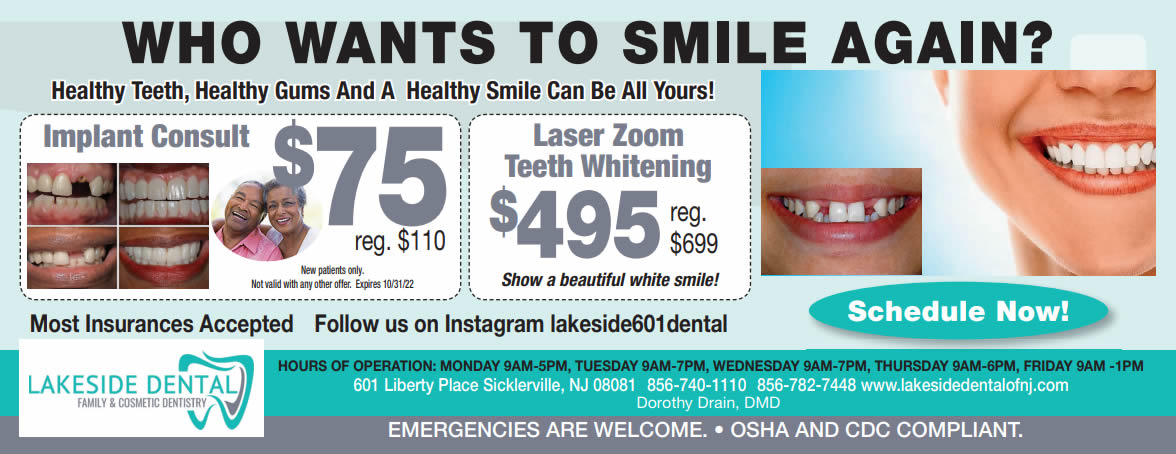
A special area of dentistry has been formed that focuses on making your smile as flawless and appealing as possible. Cosmetic dentistry corrects imperfections that cause people to feel insecure and unhappy with their smiles. If you are one of those people, maybe it’s time to see a cosmetic dentist to give you back your smile and confidence. Here are some of the most common reasons for visiting a cosmetic dentist.
One of the biggest complaints that people have about their smile is the color of their teeth. Stains can cause your teeth to become yellow or brown with time, making your smile unattractive and embarrassing. Cosmetic dentists offer teeth whitening techniques that brighten your teeth, and can restore your pearly whites in just one appointment.
Gaps in your smile from missing teeth not only look awkward, they also make chewing and speaking more difficult. A cosmetic dentist can replace your missing teeth with dental implants, bridges, or dentures. Implants have become increasingly popular because they provide a permanent, comfortable, and natural-looking solution for missing teeth.
Cosmetic dentists can solve a variety of other imperfections that make you unhappy with your smile. Veneers improve the shape and color of your teeth by covering the fronts of your teeth with thin shells. Dental fillings and root canals resolve problems often linked to tooth decay. Crowns are used to cover an unhealthy tooth and restore its strength, shape, size, and appearance. They also may be used in conjunction with dental bridges to correct gaps in your smile.
There is no reason to go through life ashamed of your teeth. Make an appointment with a cosmetic dentist to see how your smile can be improved to get the bright, beautiful smile you desire.
Contact us today to schedule your cosmetic dentistry consultation in our Sicklerville dental office.

Straight, white smiles are in high demand, and choosing who is going to perform your smile makeover is not a decision to be taken lightly. The American Dental Association does not include cosmetic dentistry as one of the eight specialties, meaning there are no legal restrictions against any dentist calling themselves a “cosmetic dentist.” Therefore, it is vital to the success of your treatment to do research and find the best cosmetic dentist to perform your smile makeover. When searching for a qualified cosmetic dentist, consider the following:
- Ask your potential dentist about their cosmetic studies. Beyond dental school, a trained cosmetic dentist should have taken postgraduate courses and training in the particular types of procedures you are seeking.
- Find out what organizations they belong to that focus solely on cosmetic dentistry. The American Academy of Cosmetic Dentistry is the most notable, and offers an accreditation program that includes extensive continuing education and rigorous testing to ensure outstanding skills. Dentists who complete this accreditation are considered to be the very best in their field.
- Ask to see “before and after” photos of patients they have treated for smile makeovers. It is important you like the style and quality of the work shown in the photos before moving forward with your chosen cosmetic dentist.
- Inquire about testimonials and reviews from patients who have been treated for cosmetic problems similar to yours. An internet search can also yield information and reviews from previous patients about the cosmetic dentist you are considering.
- Find out how long the cosmetic dentist has been practicing and which cosmetic dental procedures they most commonly perform.
- Ask about the technology in their office. Current dental technology is one way to determine the level of advanced care in a cosmetic dentistry practice.
- Is the dentist and office staff friendly, helpful, and knowledgeable?
Be sure you feel comfortable and confident with your choice of a cosmetic dentist before proceeding with a smile makeover. Making the best choice can mean enjoying years of a beautiful, bright smile.
We treat patients from Sicklerville and the surrounding area

Porcelain veneers have become a popular option in the past few years for dental patients who wish to brighten and repair their smile. While traditional porcelain veneers offer a lifelike quality and excellent durability, their placement usually requires the removal of some of the tooth surface enamel, which is an irreversible procedure.
A promising solution for patients who wish to avoid altering the tooth structure are no-prep or minimally invasive veneers. No-prep veneers offer the same advantages of traditional veneers but eliminate or reduce the need to grind, cut, or file down the teeth.
Lumineers are one of the most popular of the “no-prep” variety of veneers. Lumineers use an extremely thin veneer that is placed on the front side of your teeth. The placement of Lumineers does not require the modification of the natural tooth structure or the use of temporary veneers. Lumineers produce beautiful smiles for patients who prefer to not physically alter their teeth.
DURAthin veneers are similar to Lumineers in that they require no modification of the tooth structure or filing of the enamel. DURAthin veneers utilize very thin customized porcelain shells that match the shape and color of your teeth. These shells are roughly the width of a contact lens and are bonded to the front of your teeth. Because of their size and shape, DURAthin veneers are an ideal choice for correcting minor cosmetic dental issues.
Vivaneers are among the thinnest veneers available, making them easy to apply in as little as one office visit. Because they require no preparation to your natural tooth, there is no need for shots, drilling or anesthesia. If you are unhappy with the results, Vivaneers are easily reversible.
To find out if these or other “no-prep” veneer options would be a solution for improving your smile, schedule a consultation with a Sicklerville cosmetic dentist Dr. Drain .

Why wait until you have a toothache, bleeding gums, bad breath, or other problems to decide it’s time to start focusing on your oral health? Your mouth and your whole body can benefit from maintaining good oral health. Here is some simple advice that will help you along the path to a healthy smile.
Brushing and flossing
Tooth decay and gum disease are both preventable with proper brushing and flossing. Brush with a soft-bristled toothbrush and fluoride toothpaste, using a circular motion. It’s best to brush after every meal, but twice a day should be the minimum. Gently floss your teeth daily to remove food particles and bacteria between your teeth.
Eating right
Focusing on eating foods from each food group will aid your oral health in addition to your overall health. Not getting essential nutrients in your diet increases your risk of gum disease, and also makes it more difficult for your body to resist infection. Eat low fat dairy items, lean proteins, vegetables, fruits, and whole grains. Look for foods low in sugar, which can lead to tooth decay. Avoid snacking too much during the day when you aren’t going to brush your teeth afterwards, and drink plenty of water throughout the day.
Seeing your dentist
Visit your dentist at least twice a year for checkups. During these appointments, your dentist will look for problems and professionally clean your teeth. Delays in treatment of some conditions can cause them to worsen to the point that treatment may be more painful, difficult, or costly. Your dentist will help you keep your teeth and gums healthy so that you can keep smiling as long as possible.
If you live in the Sicklerville area contact us today

A gorgeous smile can give you confidence and open doors in your personal or professional life. A study by the American Academy of Cosmetic Dentistry found that people with bright, white smiles were viewed as more attractive, intelligent, and successful. If you don’t love the reflection you see in the mirror, a custom smile makeover can transform your smile.
For a smile makeover, your dentist will work with you to develop a detailed plan for your updates. Often, patients look at examples of the dentist’s work or they bring photos of smiles they admire with them to the consultation.
Depending on the status of your mouth and what you want to accomplish with a smile makeover, your dentist may recommend:
• Porcelain Veneers
Crafted from thin shells of porcelain, dental veneers cover imperfections such as gaps, chips, or stains. Traditional veneers are designed to complement your facial features and will produce a stunning, new image. Minimal-prep veneers, such as Lumineers, are ultra-thin porcelain shells that work for certain smiles.
• Teeth Whitening
If age, foods, beverages, or lifestyle choices have caused your smile to lose its luster, professional teeth whitening can restore brilliance. In-office chair side Zoom! whitening or an at-home whitening kit provided by your dentist can erase discolorations and brighten teeth up to 10 shades.
• Invisalign Clear Aligners
Not only will straight teeth boost your self-esteem, but they will also improve dental health. Brushing and flossing are easier when your teeth are in the correct position.
• Dental Implants
If you are missing teeth, you won’t look your best, and you may compromise your oral health. Dental implants are permanent replacements for missing teeth that will give you a sensational, complete smile.
We look forward to seeing you in our Sicklerville dental office

Your body is a little bit like a puzzle. It gives you clues to help you figure out what’s going on within your body. Did you know your mouth can give you hints about things that may be happening elsewhere in your body? Here’s a list of some of the signs your mouth can give you to pay attention to certain other aspects of your health.
Worn teeth and headache
If your teeth are showing extensive wear, you may be grinding your teeth. This would be even a stronger possibility if you’re also experiencing regular headaches, which can be caused by the muscle tension related to teeth grinding. This condition also indicates that you are likely under too much stress, and that you are unconsciously coping with it by grinding your teeth.
Gums covering teeth
If your gums begin to grow over your teeth and you are on medication, it may mean that your medication is at fault. Some medicines can cause your gums to overgrow, and the dosage needs to be adjusted.
Mouth sores
An open sore in your mouth that doesn’t go away in a couple of weeks can be an indicator of oral cancer. Numbness and unexplained bleeding in your mouth are other signs. Smokers and people over age 60 are at the most risk, but that doesn’t mean it doesn’t affect others too. See your dentist to make sure all is okay.
Cracked teeth
If your teeth begin to crack or wear extensively, you may have gastroesophogeal reflux disease (GERD). It’s a digestive disease that allows stomach acid to flow back into your food pipe and mouth. This acid can cause your teeth to deteriorate. Additional signs of GERD are acid reflux, heartburn, and dry mouth.
Unclean dentures
If you wear dentures, make sure you remove and clean them regularly. Inhaling food debris from your dentures that makes its way to your lungs can lead to pneum












